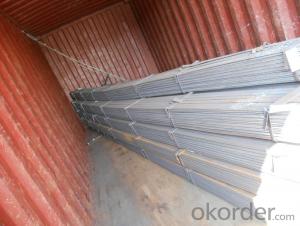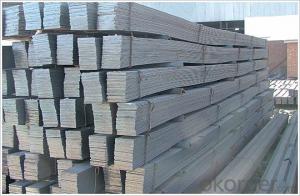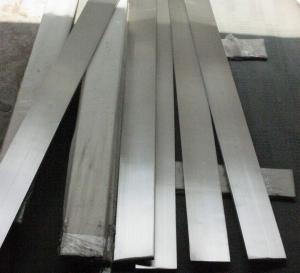Q235 Steel Flat Bar
- Loading Port:
- China Main Port
- Payment Terms:
- TT or LC
- Min Order Qty:
- -
- Supply Capability:
- -
OKorder Service Pledge
OKorder Financial Service
You Might Also Like
Product Description:
OKorder is offering Q235 Steel Flat Bar at great prices with worldwide shipping. Our supplier is a world-class manufacturer of steel, with our products utilized the world over. OKorder annually supplies products to European, North American and Asian markets. We provide quotations within 24 hours of receiving an inquiry and guarantee competitive prices.
Product Applications:
Q235 Steel Flat Bar are ideal for structural applications and are widely used in the construction of buildings and bridges, and the manufacturing, petrochemical, and transportation industries.
Product Advantages:
OKorder's Q235 Steel Flat Bar are durable, strong, and resist corrosion.
Main Product Features:
· Premium quality
· Prompt delivery & seaworthy packing (30 days after receiving deposit)
· Corrosion resistance
· Can be recycled and reused
· Mill test certification
· Professional Service
· Competitive pricing
Product Specifications:
Manufacture: Hot rolled
Grade: 235
Certificates: ISO, SGS, BV, CIQ
Length: 6m – 12m, as per customer request
Thickness: 3mm-30mm
Width:20mm-200mm
Packaging: Export packing, nude packing, bundled
Chemical composition of Q235
Alloy No | Grade | Element(%) | ||||
C
| Mn
| S
| P
| Si
| ||
Q235
|
B
|
0.12—0.20 |
0.3—0.7 |
≤0.045 |
≤0.045
|
≤0.3
|
Physical properties of Q235
Alloy No | Grade | Yielding strength point(Mpa) | Tensile strength (Mpa) | Elongation after fracture(%) | ||||||
Thickness (mm) | Thickness (mm) | |||||||||
≤16 | >16--40 | >40--60 | >60--100 | ≤16 | >16--40 | >40--60 | >60--100 | |||
≥ | ≥ | |||||||||
Q235 |
B |
235 |
225 |
215 |
205 |
375--500 |
26 |
25 |
24 |
23 |
Usage/Applications of Q235 Steel Flat Bar
Widely used for construction, Machinery manufacturing, Iron tower steel structure, Shipbuilding; Steel grating, Staircase, Bridge, Viaduct, Railway spare parts, Boilers making etc.
FAQ:
Q1: Why buy Materials & Equipment from OKorder.com?
A1: All products offered byOKorder.com are carefully selected from China's most reliable manufacturing enterprises. Through its ISO certifications, OKorder.com adheres to the highest standards and a commitment to supply chain safety and customer satisfaction.
Q2: How do we guarantee the quality of our products?
A2: We have established an advanced quality management system which conducts strict quality tests at every step, from raw materials to the final product. At the same time, we provide extensive follow-up service assurances as required.
Q3: How soon can we receive the product after purchase?
A3: Within three days of placing an order, we will begin production. The specific shipping date is dependent upon international and government factors, but is typically 7 to 10 workdays.
Images:
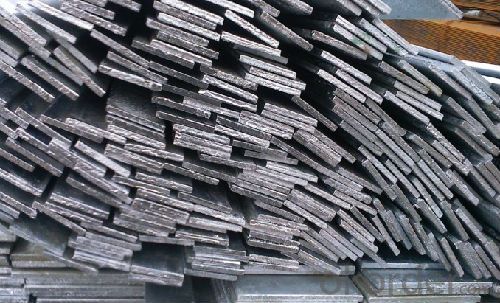
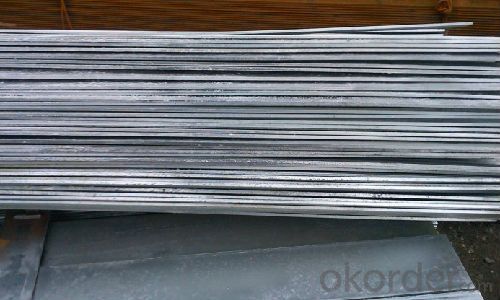
- Q:How are steel flat bars measured and specified?
- Steel flat bars are typically measured and specified by their width, thickness, and length. The width refers to the measurement across the bar's broadest side, while the thickness indicates the measurement of the bar's narrowest side. The length specifies the overall size of the bar. These measurements are important for accurately determining the dimensions and specifications of steel flat bars, allowing for proper selection and use in various applications.
- Q:Can steel flat bars be used as support beams?
- Indeed, support beams can be made from steel flat bars. Steel is renowned for its robustness and endurance, rendering it an ideal substance for structural reinforcement. In construction and engineering endeavors, steel flat bars are frequently utilized to furnish support and fortification. They can function as beams, sustaining substantial burdens and uniformly distributing weight throughout a structure. Furthermore, steel flat bars can be conveniently fabricated and trimmed to desired sizes, thereby exhibiting versatility for diverse applications. All in all, when it comes to support beams in construction undertakings, steel flat bars undeniably present themselves as dependable and efficient options.
- Q:What are the different surface defects that can occur in steel flat bars?
- Steel flat bars can exhibit various surface defects, which can arise from the manufacturing process or external factors. Some common defects include: 1. Scale: During hot rolling, an oxide layer called scale forms on the steel surface. This scale appears rough, flaky, or scaly, impacting the bar's appearance and smoothness. 2. Surface cracks: Cracks can occur due to factors like excessive cooling, improper handling, or manufacturing flaws. They vary in size and depth, compromising the steel's structural integrity. 3. Pitting: Small depressions or cavities, caused by localized corrosion from exposure to corrosive environments or improper storage, are referred to as pitting. Pitting weakens the flat bar's strength and durability. 4. Roll marks: The rolling process can leave impressions or patterns on the steel flat bar's surface. These marks occur due to irregularities or imperfections on the rolling mill rolls, affecting the bar's aesthetics and surface quality. 5. Surface roughness: Irregularities or unevenness on the steel flat bar's surface, caused by inadequate cleaning, improper handling, or wear and tear during transportation, are known as surface roughness. High roughness can affect the bar's appearance and functionality, especially in applications that require smoothness. 6. Surface contamination: Steel flat bars are prone to various forms of contamination, such as dirt, oil, grease, or foreign particles. Contamination can occur during manufacturing, handling, or storage, impacting the surface quality and potentially leading to corrosion or other performance issues. It's important to note that the severity of surface defects can vary, as can their impact on the flat bar's suitability for specific applications. Regular inspection, quality control measures, and proper handling and storage practices can minimize the occurrence and impact of these defects in steel flat bars.
- Q:Can steel flat bars be bent or shaped easily?
- Bending or shaping steel flat bars is influenced by several factors, including bar thickness, steel type, and desired bending degree. Thinner bars are generally easier to bend than thicker ones. The malleability and ductility of the steel type also affect the ease of bending. Various methods can be used to shape or bend steel flat bars, such as hydraulic presses, metal bending machines, or heat application to soften the steel. However, it is important to emphasize that specialized tools and expertise are necessary, especially for achieving precise angles or complex shapes. In conclusion, bending or shaping steel flat bars is not a simple task and requires appropriate tools, techniques, and knowledge to achieve the desired outcome.
- Q:What are the different tolerances for steel flat bars?
- The tolerances for steel flat bars can vary depending on the specific requirements and industry standards. Generally, the most common tolerances for steel flat bars are determined by the American Society for Testing and Materials (ASTM) or the International Organization for Standardization (ISO). The tolerances for steel flat bars typically include dimensions such as width, thickness, and length. These dimensions are specified to ensure that the flat bars meet certain quality standards and can be used effectively in various applications. For width tolerances, the range can vary from as tight as ±0.005 inches (0.13 mm) to as loose as ±0.25 inches (6.35 mm). The specific tolerance is typically determined based on the required precision and application of the steel flat bar. For thickness tolerances, the range can vary from ±0.005 inches (0.13 mm) to ±0.25 inches (6.35 mm). Again, the specific tolerance depends on the desired precision and application. Length tolerances for steel flat bars can range from ±0.125 inches (3.18 mm) to ±1 inch (25.4 mm). This tolerance is crucial to ensure that the flat bars can be accurately cut to the desired length and fit properly in the intended application. It is important to note that these tolerances are just general guidelines and can vary based on the specific standards set by the manufacturer or customer requirements. It is always recommended to consult the relevant industry standards or specifications to determine the specific tolerances for steel flat bars in a particular application.
- Q:Are steel flat bars available in custom sizes?
- Indeed, custom-sized steel flat bars can be obtained. Although standard sizes of steel flat bars are readily available in the market, numerous suppliers and manufacturers provide the opportunity to personalize the dimensions of flat bars according to specific demands. This grants customers the ability to acquire steel flat bars that are perfectly suited for their particular project requirements, whether it entails a distinct length, width, or thickness. The customization of steel flat bar sizes guarantees an accurate fit and maximum efficiency for a wide range of applications, encompassing construction, manufacturing, and fabrication.
- Q:What are the safety considerations when working with steel flat bars?
- When working with steel flat bars, important safety considerations include wearing appropriate personal protective equipment (PPE) such as gloves, safety glasses, and steel-toed boots to protect against potential injuries from sharp edges or falling bars. It is crucial to ensure that the work area is well-ventilated and free from any flammable materials as sparks generated during cutting or welding processes can pose fire hazards. Additionally, proper handling techniques should be followed to avoid strains or injuries, and using appropriate tools and equipment, such as clamps or vices, can help stabilize the bars and minimize the risk of accidents.
- Q:Can steel flat bars be an alternative to wood in construction?
- Steel flat bars are a viable option to replace wood in construction. They offer several benefits over wood, making them a popular choice in the construction industry. To begin with, steel flat bars are incredibly strong and durable, providing a higher level of structural integrity compared to wood. They can withstand heavy loads and resist bending or warping, making them ideal for supporting large structures or carrying heavy loads. This strength also ensures increased safety and longevity, as steel is less susceptible to damage from weather, pests, or decay. Moreover, steel flat bars are versatile and easily customizable to meet specific construction requirements. They can be cut, welded, and bent into various shapes or sizes, allowing for greater design flexibility. This versatility makes steel flat bars suitable for a wide range of structural applications, such as beams, columns, braces, or even as reinforcements in concrete structures. Furthermore, steel is a sustainable and eco-friendly material. It can be recycled indefinitely without losing its properties, reducing the need for new raw materials and minimizing waste. In contrast, wood is a limited resource that requires deforestation and can contribute to environmental degradation if not sustainably sourced. Lastly, steel is fire-resistant, providing enhanced safety in construction. Unlike wood, which is highly combustible, steel flat bars have a high melting point and do not contribute to the spread of fire. This fire resistance can be crucial in preventing the rapid spread of flames and ensuring the structure's integrity. While steel flat bars have numerous advantages as an alternative to wood in construction, it is important to consider factors such as cost, aesthetics, and local building regulations. Additionally, certain applications may still require the use of wood due to specific characteristics or design preferences. Therefore, a thorough evaluation of the project's requirements and constraints is necessary to determine whether steel flat bars are a suitable alternative to wood in a particular construction scenario.
- Q:Can steel flat bars be used for making stair treads or steps?
- Stair treads or steps can indeed be made using steel flat bars. The robustness and durability of steel make it an excellent choice for providing stability and support to staircases. By conveniently fabricating and molding flat bars, one can effortlessly fashion treads or steps that are not only functional but also visually appealing. Moreover, steel's ability to resist corrosion renders it suitable for outdoor or heavily frequented locations where stairs are typically found. Nevertheless, it is crucial to carefully deliberate on the thickness and dimensions of the steel flat bars to guarantee their ability to endure the anticipated weight and fulfill the essential safety requirements.
- Q:What is the maximum thickness-to-width ratio for a steel flat bar?
- The maximum thickness-to-width ratio for a steel flat bar depends on various factors such as the specific steel grade, intended usage, and industry standards. However, in general, the maximum thickness-to-width ratio for a steel flat bar is typically around 1:10. This means that the thickness of the flat bar should not exceed 10 times its width. Exceeding this ratio can lead to potential issues such as reduced structural integrity, increased vulnerability to bending or warping, and difficulties in fabrication or handling. It is important to consider the specific application and consult relevant industry guidelines or standards to determine the appropriate thickness-to-width ratio for a steel flat bar in a given scenario.
1. Manufacturer Overview |
|
|---|---|
| Location | |
| Year Established | |
| Annual Output Value | |
| Main Markets | |
| Company Certifications | |
2. Manufacturer Certificates |
|
|---|---|
| a) Certification Name | |
| Range | |
| Reference | |
| Validity Period | |
3. Manufacturer Capability |
|
|---|---|
| a)Trade Capacity | |
| Nearest Port | |
| Export Percentage | |
| No.of Employees in Trade Department | |
| Language Spoken: | |
| b)Factory Information | |
| Factory Size: | |
| No. of Production Lines | |
| Contract Manufacturing | |
| Product Price Range | |
Send your message to us
Q235 Steel Flat Bar
- Loading Port:
- China Main Port
- Payment Terms:
- TT or LC
- Min Order Qty:
- -
- Supply Capability:
- -
OKorder Service Pledge
OKorder Financial Service
Similar products
New products
Hot products
Hot Searches
Related keywords
